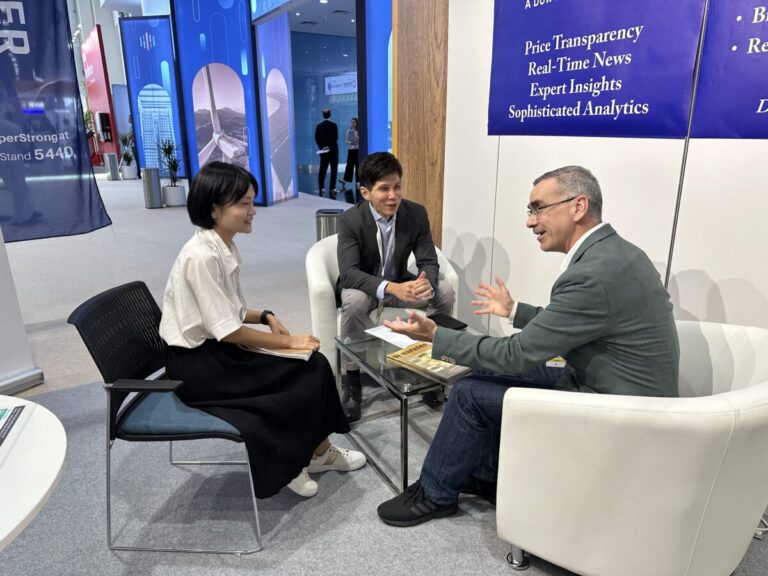At the World Future Energy Summit in Abu Dhabi, pv magazine spoke with two OPIS analysts about the current and expected price trajectory in the global supply chain. According to their analysis, overcapacity remains difficult to control, making an increase in solar panel prices very unlikely, at least in the near future.
According to Summer Zhang, Senior Analyst, Solar Supply Chain at OPIS, a Dow Jones company, there are some signs that solar panel prices could increase slightly in the second half of this year.go to pv magazine during the Word Future Energy Summit held last week in Abu Dhabi, UAE.
“The slight recovery in the upstream solar market started about three weeks ago,” she said. “This stems from polysilicon production, which has been reduced by all major polysilicon manufacturers. This gives them the opportunity to increase prices. However, this recovery in polysilicon prices is very limited and we have not seen this reflected in PV module prices, which are still on a downward trend. There are very few signs that panel prices will increase before the end of the Chinese New Year. On the other hand, there is still an oversupply.”
The analyst also said that the two largest Chinese polysilicon manufacturers are keeping their operating rates below 40%, with total Chinese polysilicon production at around 100,000 tons. “The average wafer operating speed in China has now increased to a level of more than 50%, with a total monthly production of about 48 GW,” she said.
“It is still difficult to predict now whether higher polysilicon prices will flow down to module prices,” OPIS editor-in-chief Hanwei Wu added. “If that happens, panel prices will of course rise again. However, it is unclear whether overcapacity can somehow be kept under control and whether a sustainable price recovery is in sight.”
Wu explained that if the current low production rate of polysilicon is maintained – maintaining a monthly production of about 100,000 tons – combined with the existing inventory of about 300,000 tons, the annual production capacity of 1.5 million tons would be sufficient to meet meet the expectations of end users. demand until 2025. “However, prolonged low production rates could lead to workforce displacement and financial pressure on manufacturers, raising concerns about the long-term viability of such market controls,” he says. stressed. “Additionally, the upcoming wet season three months from now in regions with significant polysilicon capacity may prompt large plants to increase production by taking advantage of lower hydropower costs, delaying capacity culling.”
According to Wu, low prices across the PV supply chain may no longer be sustainable in the future. “It is a real concern even for PV project developers themselves, as they have projects that need to last up to 30 years and key factors such as quality and guarantees may only be provided by a solid and stable industry,” he said. “Now the market is entering a phase where every time we think prices cannot be lower, the market continues to surprise us. It’s hard to say where the price floor is, but before it materializes, some market dynamics are likely to unfold, such as corporate bankruptcies or industry consolidations. This industry has a recurring pattern of self-imposed challenges, followed by attempts to repair and maintain itself.”
Zhang believes that 2025 should be a key year to reduce overcapacity. “There will be some ups and downs, but they could send the wrong signals,” she said. “For example, if we see a very low recovery in module prices, I am sure manufacturers will increase production again. This is already happening, for example, in the waffle market, where production figures have been significantly reduced compared to the third quarter of last year. More recently, however, we’ve seen a richer supply-demand balance, as well as slightly higher waffle prices, and producers are increasing production again.
The largest module manufacturers can benefit the most from the current overcapacity scenario, Wu further explains. “The solar market is now dominated by the largest five or six manufacturers,” he said. “This type of concentration will most likely increase after this period of consolidation. It’s a matter of survival of the fittest, and usually the fittest are the biggest. For example, for many of them it was extremely useful to diversify their activities into storage, hydrogen or electromobility, something that smaller companies can hardly achieve.”
“The fundamentals for a high price recovery will not be there before 2025,” Zhang added. “At least until there are clear signals that the reduction in production capacity will be evident. China’s polysilicon futures have contributed to the polysilicon rebound we’ve seen in recent weeks. If we see the futures curve projected for the period June-November 2025, we can see a scenario of stable prices. However, prices are much higher in December, indicating that industry participants believe that a substantial reduction in overcapacity is unlikely to occur until the end of 2025,” she added, noting that the main goal of most manufacturers for this year is to bring prices closer to production costs.
Zhang estimates that the average cost of Chinese polysilicon in 2024 was about CNY45 ($6.18)/kg, with variations between companies depending on their production capacity. “Sources believe there may be occasional sporadic price rebounds in the polysilicon market this year. However, a sustained increase and stable price level above CNY50/kg is unlikely to occur within the year,” she said.
“Currently, the environment does not seem to be favorable to the international free flow of trade,” Wu emphasized. “This growing protectionism around the world and in key markets will inevitably change the industry. Better to hold our breath and see where this all goes.”
This content is copyrighted and may not be reused. If you would like to collaborate with us and reuse some of our content, please contact: editors@pv-magazine.com.


